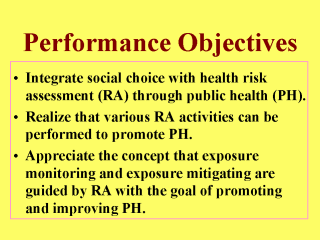| front |1 |2 |3 |4 |5 |6 |7 |8 |9 |10 |11 |12 |13 |14 |15 |16 |17 |18 |19 |20 |21 |22 |23 |24 |25 |review |
 |
By interrelating
public health (PH) with social choice/interests, and health risk assessment (RA) with
environmental health impact assessment (EHIA), you the students should be able to
appreciate that the new advances in toxicology and in epidemiology, and hence in
toxicologic epidemiology as well, are highly value- or (health) policy-bound. This
explains in part why toxicology and epidemiology as professions or academic disciplines do
not advance much in many underdeveloped countries. From learning the various example activities of RA highlighted here, you the students should realize that not all health agencies have the same interest or resources to perform all components of the RA process in fulfilling their PH mission. In addition to social choice or political values, the impact of industrialization and economic development on health is also important, especially in developing and industrial countries. In these more advanced countries, RA and EHIA activities are closely related. At the end of this lecture, you the students should be able to accept that the outcomes of an RA can and should be used as the basis for reducing the health risk involved. The most effective approach to reducing health risk is to monitor and mitigate the populationís exposure to the toxic agent at issue. |